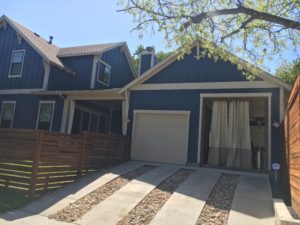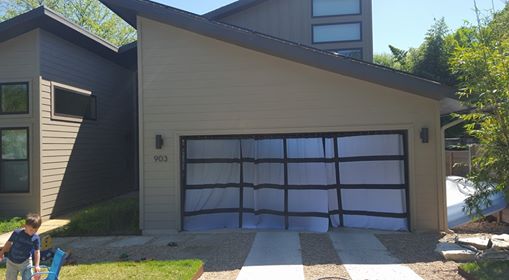Carport door raises big issues in Zilker
Friday, August 25, 2017 by
Elizabeth Pagano A recent case at the Board of Adjustment will allow one Zilker resident to finally close the door of their carport. But the case has also opened the door on neighborhood association politics and what happens when a complex Land Development Code collides with homes built to the brink of their entitlements.
Garage doors are a problem in the Zilker neighborhood, where their installation can push a home out of compliance. Because of the way the code is written, enclosing a carport can erase an exemption granted to homes, often to the surprise of homeowners unfamiliar with the intricacies of the McMansion Ordinance. In Zilker, it has led to creative solutions like hanging drapes and printing shower curtains to look like solid doors in a bit of ingenuity whose tackiness is not prohibited by the city.
By installing a garage door on her carport to deter would-be thieves and vandals, Maureen Lamb, who owns the home at 2005 Bluebonnet Lane with her husband, entered the fray. She came to the board seeking a variance for the door and explained the steep slope from the driveway to the carport made trespassing attractive because it was hard to see into the carport. She speculated that the proximity to a school bus stop may also have contributed to some of the vandalism they had experienced.

Installation of the door created a structure that no longer complies with the carport gross floor area exemption, so to retain the door they would need to increase their allowed maximum floor area ratio. As a compromise struck with the Zilker Neighborhood Association, she proposed removing 60 percent of the wall closest to their home, which would make the majority of two walls on their carport open.
In the end, Board of Adjustment members agreed on Aug. 14 to grant the variance, voting 10-1 for its approval, with conditions. Board Member Don Leighton-Burwell voted in opposition.
Board Member Bryan King explained that it was “such a testy case” because the builder had pushed their entitlements to the hilt. “When it’s that close, it puts buyers in the position that they can’t do anything,” he said. “In this case, you bought a house that wasn’t entitled to a garage door.”
“This is more than just about one garage door. It’s a string of push, push to the max,” said King. “Unfortunately, homeowners that buy it don’t understand that.”
In this case, despite the Zilker Neighborhood Association’s wariness, Lamb had documented the support of 224 of her neighbors for the variance.
“It was a lot of walking, but I thought the best way to show that the neighborhood really was OK with our variance request was to go out and speak to them personally,” said Lamb.
Mary Owens, who is the secretary of the neighborhood’s other association, Friends of Zilker, spoke “emphatically” in favor of the variance. She told the board that the organization had voted 34-1 to support the variance. She showed the board various ways neighbors had solved the problem of enclosing their carports without running afoul of the McMansion Ordinance, including one neighbor that had printed a shower curtain to look like the panes of a garage.
“I don’t know how many people the Lamb family needs approval from to get their garage door, but it shouldn’t be up to the three people that are on the Zilker Neighborhood Association (executive committee),” said Owens. “I am a member of that organization and I yelled and screamed at the last meeting to let the membership vote. A whole lot of us are just fine with garage doors and they never let us speak.”
Though Zilker Neighborhood Association President Jeff Jack said that Owens’ testimony made him want to change his position, he told the board that association had taken a stance of “non-opposition” on the case after it agreed that the garage orientation would remain constant and two of the carport walls were open.
Jack explained that the case was a difficult one for the neighborhood association. He said that in 2013, when he was chair of the Board of Adjustment, the home’s builder had sought a similar variance that was denied. (Lamb later clarified that their variance was different than the 2013 request from the builder that sought to enclose the garage on all sides.)
“A FAR variance is not just about aesthetics. It’s about buildable area and the potential for closing it in and making habitable space out of it. The applicant in this case has said they aren’t going to do that, but to assume that FARs are simply a matter of aesthetics is incorrect,” said Jack.
Though Board Member Brooke Bailey voted in favor of the variance, like most of the board, she did so reluctantly.
“I know for you guys it’s one person and your neighbor, and one door, and one FAR,” she said. “For us, these are cases we see every month, over and over. It sets a pattern, and a pattern I don’t like. I don’t like this case. I don’t like the pattern that it sets. I don’t like the next person that’s going to come in and say, ‘Well, they got a garage door, why can’t we?’
“I’m voting yes, but I will say I don’t like it,” she said.
Photos courtesy of Friends of Zilker.
The Austin Monitor’s work is made possible by donations from the community. Though our reporting covers donors from time to time, we are careful to keep business and editorial efforts separate while maintaining transparency. A complete list of donors is available here, and our code of ethics is explained here.
You're a community leader
And we’re honored you look to us for serious, in-depth news. You know a strong community needs local and dedicated watchdog reporting. We’re here for you and that won’t change. Now will you take the powerful next step and support our nonprofit news organization?







